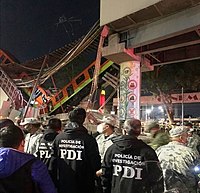Our website is made possible by displaying online advertisements to our visitors.
Please consider supporting us by disabling your ad blocker.
Mexico City Metro overpass collapse
| Mexico City Metro overpass collapse | |
|---|---|
 Investigators on site the night of the collapse | |
 | |
| Details | |
| Date | 3 May 2021 22:22 CDT (UTC-5) |
| Location | Tezonco–Olivos elevated interstation Tláhuac Avenue, Tláhuac, Mexico City |
| Coordinates | 19°18′18″N 99°03′41″W / 19.3049°N 99.0613°W |
| Country | Mexico |
| Line | Line 12 |
| Operator | Sistema de Transporte Colectivo (STC) |
| Incident type | Railway collapse |
| Cause | Structural failure caused by faulty welding and lack of functional studs that led to fatigue in the collapse point |
| Statistics | |
| Trains | 1 |
| Vehicles | 1 |
| Crew | 1[2] |
| Deaths | 26[1] |
| Injured | 98[1] |
On 3 May 2021, at 22:22 CDT (UTC−5), a girder overpass in the borough of Tláhuac carrying Line 12 of the Mexico City Metro collapsed beneath a passing train. The overpass, along with the last two railcars of the train, fell onto Avenida Tláhuac near Olivos station, resulting in 26 fatalities and 98 injuries. It was the deadliest accident in the Metro's history in nearly fifty years.
Before the line opened, it faced technical and structural issues that persisted during its operation, resulting in a partial closure of the elevated section where the accident occurred, lasting from 2014 to 2015. An earthquake in 2017 further damaged the structure; although repairs were completed within a few months, residents reported that problems persisted for years. Originally announced in 2007 as an underground line capable of operating rubber-tired trains due to the instability of the city's soil, the line was scheduled to open in 2010. However, budget and time constraints led to modifications that allowed underground and above-ground operation with steel-wheeled trains. Researchers have identified this design change as a factor in track instability and damage since the line commenced operations. The construction was carried out by Empresas ICA, in partnership with Alstom Mexicana and Grupo Carso, the latter owned by businessman Carlos Slim.
Claudia Sheinbaum, the head of government of the city at the time of the collapse, hired the Norwegian risk management firm Det Norske Veritas (DNV) to investigate the causes of the event. Preliminary findings indicated that the accident was linked to bridge construction deficiencies, including a lack of functional studs and faulty welds, fatiguing the collapsed beam. Further investigations concluded that the bridge was designed and built without adhering to quality standards, that both the construction and the line's design changes were inadequately supervised, and that there were insufficient fixing and safety elements. Additionally, it was found that periodic maintenance checks, which could have detected the girder buckling, had not been conducted—a claim contested by the city government.
Carso, the company responsible for constructing the collapsed section, denied any wrongdoing; however, Slim agreed with the Mexican government to repair the section at no cost. In December 2021, the city's attorney general's office filed charges against ten former officials involved in the construction and supervision of the project, including the project director, Enrique Horcasitas. As of January 2025, they were awaiting trial for manslaughter, injury, and property damage. The bridge was rebuilt, the sections constructed by Carso were reinforced, and the line underwent general maintenance, fully reopening on 30 January 2024.
- ^ a b Cite error: The named reference
ledewas invoked but never defined (see the help page). - ^ Olvera, Dulce (4 May 2021). "El conductor del tren de la L12 está hospitalizado. Trabajadores exigen revisar todo el Metro" [The driver of the L12 train is hospitalized. Workers demand to overhaul the entire Metro]. SinEmbargo.mx (in Spanish). Archived from the original on 5 May 2021. Retrieved 5 May 2021.
Previous Page Next Page
انهيار مترو مكسيكو سيتي 2021 Arabic Срутване на надлез на метрото в Мексико сити Bulgarian Zřícení nadjezdu metra v Ciudad de México Czech Sammenstyrtning af metrooverføring i Mexico City Danish U-Bahn-Unfall Mexiko-Stadt (2021) German Accidente del Metro de la Ciudad de México de 2021 Spanish فرو ریختن پل متروی مکزیکوسیتی FA Accident de métro du 3 mai 2021 à Mexico French התמוטטות גשר המטרו במקסיקו סיטי HE Keruntuhan rel layang angkutan cepat Kota Meksiko 2021 ID


